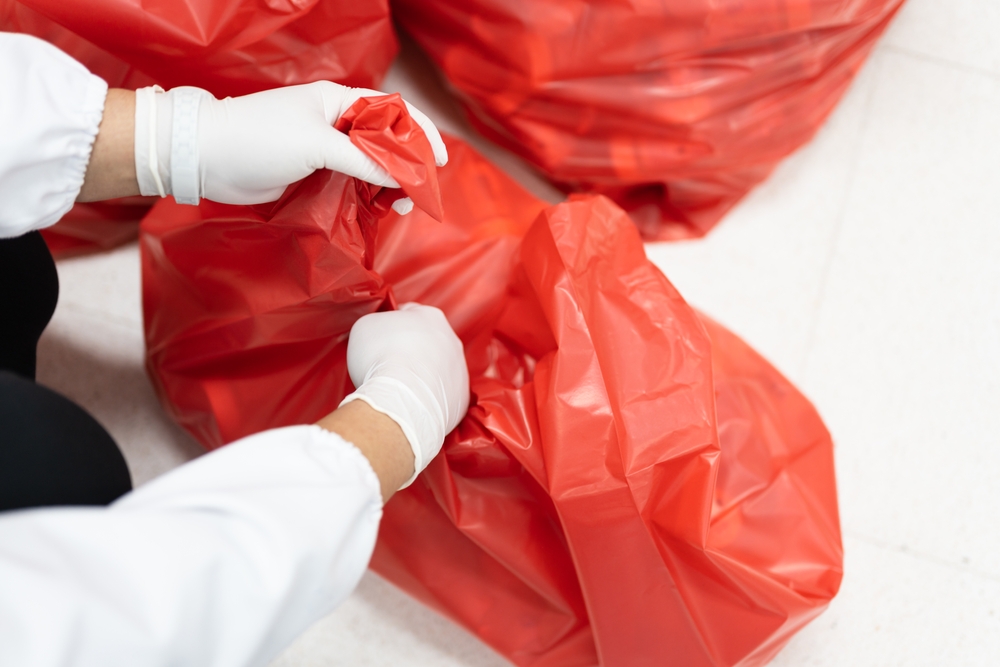As we’ve all paid a lot more attention to avoiding illness the past couple of years, we’ve also had to think about some new kinds of waste. We’re figuring out how to recycle disposable masks and properly dispose of cloth masks to avoid PPE pollution. We worry whether all those little plastic bottles of hand sanitizer will end up polluting the ocean and if cloth masks expose us to toxins. It’s almost enough to make you want to take your chances against infection. But even if there’s an environmental cost to staying well, it’s important to keep it in perspective. Let’s take a look at the environmental cost of getting sick.
Disposable PPE
If you feel bad about using disposable masks to prevent infection in daily life, just think how many single-use masks and gloves are used for a single doctor visit. It’s estimated that a single intensive care hospital worker will use 10 simple masks per day, and change gloves with each patient encounter, generating a total of 340 individual gloves daily. In an outpatient setting, a healthcare worker may use 50 gloves and at least two simple masks per day. During normal years, hospitals use about 5,000 to 6,600 N95 masks per year; in a pandemic, the number is 10 times higher.
Hospital Waste
There is a lot more to hospital waste than PPE; hospital waste includes everything from disposable straws and trays of food waste from bland, half-eaten meals. Think about the waste generated from a single injection. First, there is the single-use swab to sterilize the injection site. The medication will be packaged in small, sterile containers, as will the single-use plastic syringe, its needle, and the bandaid. Sterile medical packaging is less efficient by necessity, requiring extra layers of packaging, which is mostly made up of unrecyclable plastic. The needle must be disposed inside of a sturdy plastic sharps container. Medical sharps waste must be handled by a special medical waste management company. When it’s full, the container must be sterilized before being sent to a landfill or incinerator. Neither the plastic container nor the metal needles can be recycled.
One hospital case study found an environmental footprint 739 times the facility’s actual size. Health care facilities can generate up to 25 pounds of waste per day per patient, adding up to nearly 7,000 tons of waste per day across the country.
Hospitals are also energy hogs, requiring intensive versions of the same systems used in homes: brighter lighting in operating rooms; increased air exchange and filtration and decreased temperature variation in HVAC systems. Medical machinery from X-ray machines to heart rate monitors all draw electricity. An average U.S. hospital uses 31 kilowatt-hours (kWh) of electricity and 103,600 Btu of natural gas per square foot annually (compared to about 5 kWh per square foot per year in an average, 2,300-square-foot home).
Biohazards and Other Special Wastes
About 15% of hospital waste is infectious, toxic, or radioactive. Regulated medical waste includes sharps (needles and razors), biohazards (items that are potentially contaminated with infectious matter), and radioactive waste (from diagnostics and therapeutic treatments, including for cancer). Hospitals generate a pound of biohazardous waste per patient per day. Disposing of regulated medical waste costs up to 10 times more than disposing of municipal solid waste and up to 30 times more than recycling.
Dangerous Disposal
Proper disposal of regulated wastes and other hazardous chemical wastes, such as cleaning products, is not easy. Landfill disposal of untreated wastes increases the risk of contaminating drinking, surface, and groundwater. But treating medical waste requires the use of chemical disinfectants that themselves present environmental risks. Although incineration prevents the release of medical wastes into the environment, it is not without its own environmental drawbacks. Recycling medical waste is a promising option for waste reduction, but it is not yet widespread, and sterilization is still a water- and energy-intensive process.
Even if you don’t have to go to a hospital, getting sick is costly. You might go through cloth handkerchiefs faster than you can wash them and have to resort to disposable tissues (maybe try tree-free tissue) when you have a cold. Once you feel better, disposing of leftover medications can be challenging.
Be Well
Of course, there are a lot of ways for hospitals to reduce waste. Nearly half of hospital waste is paper and cardboard, which is recyclable. Just as other businesses do, hospitals can establish recycling programs and protocols for the proper separation of wastes. They can install solar panels and take energy efficiency measures from insulation to lights that automatically switch off in unused rooms. But there is not much a patient can do to support those actions. So, if your own health is not already motivation enough, try to stay healthy for the planet.
This post, The Environmental Cost of Getting Sick, was first shared by Earth 911 on December 20, 2021.











